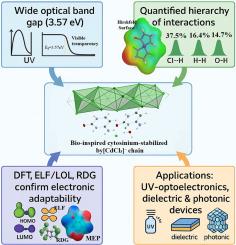由胞嘧啶稳定的仿生一维卤化镉:结构、光谱和理论研究
IF 4.7
2区 化学
Q2 CHEMISTRY, PHYSICAL
引用次数: 0
摘要
受生物分子识别策略的启发,杂化有机-无机卤化镉由于其结构多样性和可调谐的物理性质,正在成为光电和介电应用的通用材料。在这项研究中,我们报道了一种新的含胞嘧啶离子的氯化镉杂化化合物的合成和综合表征;二(胞嘧啶)氯化三氯酸盐水合物(1)。单晶x射线衍射揭示了一个单斜斜结构,它由无限的[CdCl₃]毒链组成,通过氢键和静电相互作用相互连接。光谱分析(UV-Vis和FTIR)证实了与无机框架和有机阳离子相关的光学透明度和振动特征,而扫描电镜图像显示出明确的针状形态。密度泛函理论计算、Hirshfeld表面分析和全相互作用图(FIM)提供了对稳定晶格的电子结构和分子间相互作用的进一步了解。这项工作首次强调了将含氮核碱基(胞嘧啶)整合到氯化镉杂化体系中,为多功能晶体材料提供了仿生途径。这些结果为设计具有潜在光电和介电功能的生物启发卤化物框架铺平了道路。本文章由计算机程序翻译,如有差异,请以英文原文为准。

Bio-inspired one-dimensional cadmium halide stabilized by cytosinium: Structural, spectroscopic and theoretical investigations
Inspired by biomolecular recognition strategies, hybrid organic–inorganic cadmium halides are emerging as versatile materials for optoelectronic and dielectric applications, owing to their structural diversity and tunable physical properties. In this study, we report the synthesis and comprehensive characterization of a new cadmium chloride hybrid compound incorporating cytosinium cations; Bis(cytosinium) chloride trichlorocadmate hydrate (1). Single-crystal X-ray diffraction reveals a monoclinic structure composed of infinite [CdCl₃]⁻ chains interconnected by hydrogen bonding and electrostatic interactions. Spectroscopic analyses (UV–Vis and FTIR) confirm the optical transparency and vibrational features associated with the inorganic framework and organic cations, while SEM images show a well-defined needle-like morphology. Density functional theory calculations, Hirshfeld surface analysis and full interaction maps (FIM) provide further insight into the electronic structure and intermolecular interactions that stabilize the crystal lattice. This work highlights, for the first time, the integration of a nitrogenous nucleobase (cytosine) into a cadmium chloride hybrid system, offering a biomimetic pathway toward multifunctional crystalline materials. These results pave the way for the design of bioinspired halide frameworks with potential optoelectronic and dielectric functionalities.
求助全文
通过发布文献求助,成功后即可免费获取论文全文。
去求助
来源期刊

Journal of Molecular Structure
化学-物理化学
CiteScore
7.10
自引率
15.80%
发文量
2384
审稿时长
45 days
期刊介绍:
The Journal of Molecular Structure is dedicated to the publication of full-length articles and review papers, providing important new structural information on all types of chemical species including:
• Stable and unstable molecules in all types of environments (vapour, molecular beam, liquid, solution, liquid crystal, solid state, matrix-isolated, surface-absorbed etc.)
• Chemical intermediates
• Molecules in excited states
• Biological molecules
• Polymers.
The methods used may include any combination of spectroscopic and non-spectroscopic techniques, for example:
• Infrared spectroscopy (mid, far, near)
• Raman spectroscopy and non-linear Raman methods (CARS, etc.)
• Electronic absorption spectroscopy
• Optical rotatory dispersion and circular dichroism
• Fluorescence and phosphorescence techniques
• Electron spectroscopies (PES, XPS), EXAFS, etc.
• Microwave spectroscopy
• Electron diffraction
• NMR and ESR spectroscopies
• Mössbauer spectroscopy
• X-ray crystallography
• Charge Density Analyses
• Computational Studies (supplementing experimental methods)
We encourage publications combining theoretical and experimental approaches. The structural insights gained by the studies should be correlated with the properties, activity and/ or reactivity of the molecule under investigation and the relevance of this molecule and its implications should be discussed.
 求助内容:
求助内容: 应助结果提醒方式:
应助结果提醒方式:


